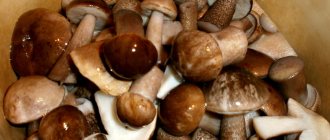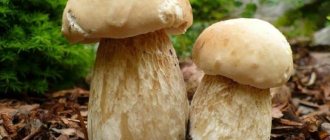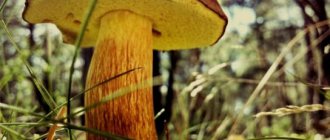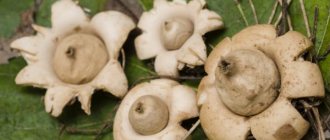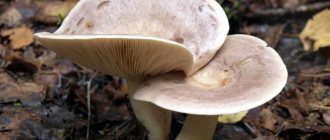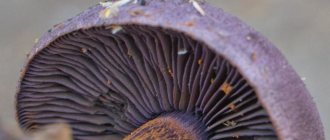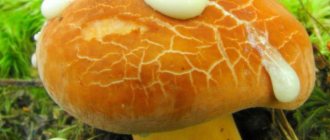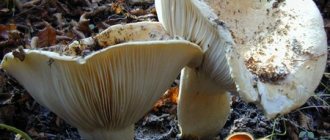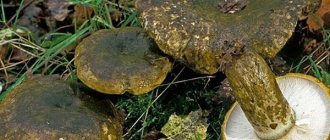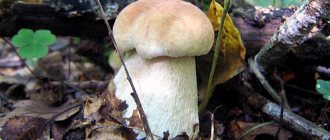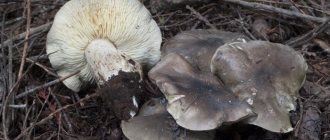What is another name?
Serushki is just one of many names. This mushroom has more than a dozen of them. In Russia, depending on the region, these mushrooms are called:
- way;
- gray hollow;
- bitter;
- purple milk mushroom;
- gray milky;
- plantain;
- traveler;
- seryanka;
- gray
The names reflect all the remarkable properties of the mushroom - its taste, color, favorite places of growth, secretion of milky juice.
Botanical description of serushka mushrooms
The fruiting bodies are represented by a convex and funnel-shaped cap with a fairly pronounced tubercle in the central part and uneven, wavy and inwardly curved edges. The surface is covered with pinkish-gray, violet-grayish, brownish-lead skin, often with the presence of not too pronounced, concentric zones. The plates are of an adherent type, sparsely located, quite often tortuous, yellow in color.
The spores have a very characteristic yellowish color, spherical in shape, with an ornamented surface. The stem has a fairly dense consistency or is internally hollow, similar in color to the cap or a slightly lighter shade, cylindrical in shape, with longitudinal grooves on the surface. The pulp is white in color, dense in consistency, with a fruity aroma and abundant, white, caustic milky juice that does not change color when exposed to air.
Features of serushki
The gray milkweed is perfectly camouflaged in grass and pine needles. This wetland lover is easy to spot. And not so much by its appearance - although it has bright signs - but by the drops of bitter juice protruding from the cut.
Putik is beautiful in its own way. It not only has an original taste, but also a refined appearance. Description of species characteristics:
- Hat. Color – gray-lilac. May have a pinkish, purple and lead-brown tint. The hat is smooth to the touch, but slippery after rain. At the top there are concentric circles. The shape is funnel-shaped. In small mushrooms it is convex. The cap edges are uneven, drooping or curved inward. The diameter of the cap of an adult mushroom is 5-10 cm.
- Records. They are distinguished by their rare location. Color – pale yellow, beige.
- Controversy. Yellow color.
- Leg. It has a cylindrical shape. Swollen or narrowed at the base. In adult mushrooms it is hollow. The color will repeat the color of the plates or cap. Reaches a width of 2 cm, a length of 8 cm.
- Pulp . Dense, elastic. Has a fruity aroma. White color. At the break, a milky juice is released - it has an extremely bitter taste. The mushroom does not change color when cut.
The difference between serushkas and false doubles
Mushrooms, despite their uniqueness, have doubles. There are not very many of them, but when collecting them you need to be able to distinguish them so as not to harm your health.
Milky zonal
The main distinguishing features of this type are the following:
- ocher or cream-colored surface of the cap;
- yellow-brown color of the legs;
- ocher spore powder;
- whitish pulp with a burning taste.
This type of fruit is considered conditionally edible and is only suitable for pickling.
Milky zoneless
The distinctive features of this type are the following characteristics:
- the top is velvety, changing shades from brown to sand;
- cream-colored plates that darken with age;
- the pulp is white, odorless;
- the leg is hard with a smooth surface.
In order to finally make sure that this is a twin of the harlequin, you need to damage its fruiting body. After contact with oxygen, it changes its color from white to orange-pinkish.
Gorkushka
The distinctive properties of this type are the following:
- the bell-shaped cap of young fruits becomes flat as it ages;
- there is a tubercle in the center of the apex;
- brittle and dense pulp, with a peppery taste;
- thin, reddish leg.
You can visually distinguish a serushka from all false twins by the centric circles that are located on its surface. They have either a gray or purple tint.
Where and when does it grow?
Serushki are regulars in deciduous and mixed forests. Distributed almost throughout the entire territory of Russia. Preference is given to the northern regions and Siberia. It is also found in the Urals and the Far East. They grow well in moist soils - loamy and sandy loam. They love birch and aspen forests, especially lowland ones.
For graylings, it is better to go to well-lit deciduous forests - birch and aspen forests. They love moisture, so it's best to look for them after rain. The harvest season begins in July and lasts until September. In a drought, you can’t count on a harvest of putik. What collectors need to know:
- The mushroom is productive - it grows in groups. But it can also grow alone. Favorite places to grow are forest edges and paths.
- The collection period is from early summer to October.
- The color of the cap varies from gray to yellowish-gray and ocher.
In the video, experienced mushroom pickers are looking for earrings. In forest conditions, they will talk about the characteristics of the growth and harvesting of these mushrooms:
How to pickle earrings (video)
Mushroom caviar made from serukh turns out to be very tasty. For one and a half kilograms of mushrooms you need to use 300 g of tomatoes, a teaspoon of ground black pepper and a teaspoon of chopped garlic cloves. Boiled serukhs are passed through a meat grinder and stewed with constant stirring with a small amount of refined vegetable oil. About five minutes from the start of cooking, tomatoes chopped in a blender are added, and after another quarter of an hour, garlic, spices and salt are added. Hot mushroom caviar is placed in sterile jars, and a few drops of vinegar essence are added, after which the workpiece is rolled up with metal lids. It is advisable to store canned mushrooms for no more than six months, in a cool and dark place.
Post Views: 328
Who can be confused with?
Putiki are most often confused with greenfinches, which are not even classified as milkweeds. These mushrooms are from the row family. Inexperienced mushroom pickers confuse white mushrooms with two types of green mushrooms:
- With a separate row. Unlike the lilac-gray putik hat, this row has an olive-brown color, with a darkening in the center. Along the curved edge there are sparse scales and a greenish color. The leg is light green, olive or white, the lower part is darker - it is dark gray or black. The color of the pulp is white or pale yellow. The taste, like putik, is bitter. There is a powdery smell.
- With deciduous green grass . Unlike seruha, greenfly has a wide hat - conical, bell-shaped or outstretched. In the center there is a tubercle. The color of the cap is pale yellow, mustard yellow, greenish brown. On top there are concentric scales - yellow-brown or brownish-greenish. Greenflies have yellow, notched-adherent plates and a cylindrical stalk, widened at the base. The pulp is white or yellow. Taste and aroma are weakly expressed.
The gray milkweed or serushka is very similar in appearance to the common milkweed. There is nothing terrible in this similarity - all representatives of the milkweed family are suitable for food, and if some of them are considered inedible, it is only because of the bitter taste, and not because of poison. Serushki are especially similar to two milkweeds:
- Zonal. It has a cream or ocher cap.
- Zoneless. It is painted in brown shades.
It is easy to distinguish putiki - only their juice released at the cut does not change color at all. In similar mushrooms, the juice darkens when in contact with air.
Use
Like most similar and related species, the serushka is especially valued in its salted form.
Before salting, the serushka must undergo pre-treatment to get rid of bitterness, namely, soaking in cold water for two to three days with regular changes of water.
This process is labor-intensive, but the result is worth it - salted serushka is extremely tasty. In a number of regions, serushka is also consumed fresh, fried or boiled, after a rather long preliminary boiling.
The value and benefits of the mushroom
Easily digestible purple milk mushrooms are considered a dietary product; they contain only 18.5 kcal. They belong to the third food category. Indicators of their nutritional value:
- proteins - 3.09 g;
- carbohydrates - 3.26 g;
- fats - 0.34 g;
- water - 91.46 g;
- fiber - 1 g;
- ash - 0.85 g.
Purple milk mushrooms are also rich in:
- vitamins C, D, E, B6, B12, K1;
- folic acid;
- thiamine;
- riboflavin;
- nicotinic and pantothenic acids;
- choline;
- betaine.
Travelers are also high in selenium, calcium, magnesium, potassium, zinc, phosphorus, iron, copper and manganese. Serushki are valued for their rich set of vitamins, microelements and amino acids. These mushrooms contain beneficial elements in the most favorable proportions. Scientists say that this is the most winning combination. Perhaps this is why putiki were so actively used in folk medicine. With its help, many diseases were treated - from skin lesions to consumption and cholera.
Purple milk mushrooms strengthen the immune system and blood vessels, nourish the brain, and cleanse the body of heavy metal salts.
What does the seryanka mushroom look like? Advantages of a mushroom for a mushroom picker
Seryankas are lamellar mushrooms from the genus Lacticaceae of the Russula family. So their “relatives” are very, very decent. There are saffron milk caps, and milk mushrooms, and volushki, and saffron milk caps, and a whole range of other, quite edible and high-quality mushrooms.
The seryanka mushroom, also known as serushka, is not like any of the poisonous and inedible mushrooms. And this is already its first advantage, especially for inexperienced mushroom pickers.
Here is a photo of the seryanka mushroom, please admire it.
Seryanka mushroom
As you can see, the mushroom is also quite beautiful! The grayish-violet color of the cap with implicit concentric rings makes it very elegant and attractive.
However, you need to take into account that there are two varieties of this mushroom. In the next photo there is also a seryanka mushroom, but a little different in appearance. Its hat is light gray, even yellowish, the edges are slightly fluffy. In wet weather, such seryankas will be somewhat slimy.
Seryanka too
These mushrooms, despite the differences in appearance, do not differ in either quality or culinary characteristics. So you can safely take both of them, no matter how they look on the outside.
The seryanka mushroom has a feature characteristic of all laticifers - drops of milky juice stand out on the cut, and often on the plates. This juice from the seryanka is caustic, white, and does not change color in air.
The plates of the mushroom are quite rare and large. The pulp is dense, white. The leg is hollow. Seryanki do not wrinkle in the basket. This is another advantage of them, because sometimes mushroom pickers carry their prey over a fairly long distance. Another advantage for a mushroom picker is that mushrooms are almost not affected by insect larvae.
As autumn approaches, the soil near many of these mushrooms' large fruiting bodies (about 15 centimeters in diameter) will often be strewn with white powder. These are scattered spores of the fungus. It is unlikely that you should take such a seryanka - it is already overripe.
About the names of the mushroom
The hollow stem gave rise to another name for the seryanka mushroom. Sometimes it is called a nest box. In general, there are quite a lot of names. This mushroom is called serushka, putik, traveler, plantain. The last three names note that forest roads and paths, including abandoned ones, are a very favorite habitat for the mushroom.
Harm of earrings
Medicinal decoctions from earrings should be taken with caution by people with gastrointestinal diseases, pregnant women, lactating women, and people with allergies. They are also not recommended to overuse any mushroom dishes. Abuse of earrings can provoke:
- Allergic reaction. It can result in constipation, digestive disorders, and even abscesses on the gastric mucosa.
- Poisoning. The mushroom contains a lot of chitin. Overeating can cause nausea, vomiting, diarrhea, chills, bloating, dizziness, and other symptoms of an eating disorder.
- Inflammation of the duodenum.
- Frequent urge to urinate.
- Corrosion of the stomach walls by bioactive components.
The components contained in serushki can destroy muscle cells and cause kidney failure.
Despite the abundance of beneficial properties, earrings must be treated with caution. They contain elements that thin the blood and prevent its clotting. Putiki are strictly contraindicated for bacterial vaginosis and dropsy.
Serushki belong to the Russula family, the genus Lactaceae. Due to their bitterness, mushrooms are classified as conditionally edible in the third food category. Putik is quite tasty when salted, but it must first be thoroughly soaked to remove the bitterness. Soaking lasts several days. The bitter juice saves the mushrooms from worms and insects, so the mushroom can be salted without fear of worms. Demand for putiki appears, as a rule, in years that are poor for other mushrooms.
Indications and contraindications for use
According to the description, greenfinch is not harmful to humans, so there are no strict contraindications. At the same time, soaking in water is extremely important to get rid of the unpleasant aftertaste.
Serushki are edible even in their raw form, but be sure to use moderation, because overeating will have a bad effect on digestion, and for gastrointestinal diseases, it is better to consume mushrooms in minimal doses.
Since September, spores can be found near mushrooms on the surface of the soil or vegetation - they look like white powder. This signals the “adulthood” of the mushroom, it has reached an age when it is no longer worth collecting, because it has completed its mission and now the fruiting body will begin to collapse.
Gray-purple milkweed contains many polysaccharides that help strengthen the immune system, so it is often used in the preparation of tinctures, decoctions and even ointments. All this helps in the treatment of human skin and internal organs.
Serushki have an excellent antiparasitic effect and are able to cope with many types of worms.
Cooking features
Putiki are bitter - this is the main thing to remember when sending them for processing. The mushroom does not have any special taste, but it is ideal for assorted mushrooms.
Before salting or pickling, earrings are soaked for three days to remove the bitterness. After soaking, the mushrooms do not lose their rich color. But it is not recommended to subject them to long-term heat treatment - the earrings lose their taste. When marinating, boil the mushrooms for no more than 20 minutes.
What's good about putik is that it has clean pulp - worms don't like it. Usually, starting with the stem, they quickly give up, and the caps remain pristinely intact - this is very convenient and profitable for recycling.
Collection rules
Since the fruiting bodies of gray moths tend to absorb harmful substances from the air and soil, they should not be collected in environmentally unfavorable areas - near busy highways, landfills, industrial enterprises.
Mushrooms should be carefully cut and not uprooted. In this way, you can ensure that they will produce more than one harvest. Serushka has no dangerous counterparts, but if during the collection process doubts arise as to whether the mushroom is suitable for food, it is better to leave it in the clearing and not put your health at risk.
Is it possible to grow earrings?
To grow earrings, you need mycelium, substrate and appropriate conditions. All this requires investment, so growing mushrooms is usually practiced as a business.
Serushki, in comparison with champignons, porcini mushrooms, edible polypores or caps (cockerels), are not in mass demand. Moreover, many mushroom pickers are even unfamiliar with this mushroom. And the bitter taste of putik, which makes cooking difficult, sealed its fate - it is unprofitable for industrial cultivation. Artificial production of putik is not developed.
When prepared correctly, earrings can become a valuable nutritious dish. This is not the most popular mushroom in the ranking of mushroom pickers, but, having an original taste, it invariably finds its fans. The mushroom does not require special cultivation, since it is rarely used in nutrition and other areas.
0
0
Copy link
How to distinguish edible from inedible
Among all types of rows, half of them are edible and will not cause harm to the body, and half are false ones, which are poisonous. Let's figure out how to distinguish the serushka mushroom (photo) from edible and poisonous.
Poisonous mushrooms include white, sulfur, sulfur-yellow, soap, mouse, tiger and other types of rows. Young white rowers differ in the color of their cap, young ones have a white tint, more mature ones have brown spots. The appearance of the leopard print pattern resembles the fur pattern of a tiger or leopard. The color of the flesh of this mushroom is gray.
Mouse rows are colored gray inside, and the taste is quite unpleasant and burning. Mushrooms with a yellow cap should also not be eaten, since when cut, the mushrooms begin to emit hydrogen sulfide. Soap rows are not hazardous to health, however, after cooking they have a soapy taste and are impossible to eat.
Secrets of cooking at home
The following secrets will help you when salting travelers:
- Using a toothbrush is more convenient to clean mushrooms from various debris and leaves that often stick to the cap. The main thing is not to put too much pressure on the mushrooms so that they don’t start to crumble.
- When soaking, you must ensure that the marinade completely covers the earrings. Otherwise, they will become covered with mold and it will be difficult to wash it off.
- For pickling, it is better to use enamel dishes, glass jars, and wooden barrels. But it’s better not to take dishes made of clay - the salt will corrode the top layer of the material, as a result of which elements hazardous to health can get into the brine.
Serushki are excellent mushrooms for pickling and pickling. However, it is important to remember the need for careful preparation and soaking. This will remove harmful substances from travelers and avoid poisoning.
Birch russula mushroom (Russula betularum)
Category: inedible.
Cap of birch russula (Russula betularum) (diameter 3-7 cm): from beige or yellow to pinkish or with a lilac tint. Like other russulas, young mushrooms have a slightly convex or hemispherical shape, and over time it becomes almost flat or slightly depressed. The skin, slippery in wet weather, is easily removed from the pulp.
Leg (height 3-9 cm): cylinder or club-shaped, usually white. Very brittle, depending on the age of the mushroom it can be either solid or hollow.
Lamellae: white and frequent, may be attached or almost completely free, and sometimes torn.
Pulp: white, very brittle and pungent in taste. It has an aroma similar to that of fruit, honey or coconut.
Doppelgängers: related Russula graceful (Russula gracillima), brittle (Russula fragilis) and caustic (Russula emetica). The most elegant one differs from the birch one in its paler color and smaller size. In brittle, the skin is easily removed from the cap only halfway, and the caustic russula, larger and more deeply colored, grows next to coniferous trees.
Where to find: in damp places in the forest or near swamps. As the name suggests, it prefers to grow next to birch trees.
Eating: very caustic, therefore not used in cooking.
When it grows: from mid-June to early October. Listed in the Red Books of Denmark, France, Norway
Use in folk medicine: not used.
Share this article:
Cooking methods: recipes, how to pickle, preservation
You can prepare greenfinches in various ways. They can be fried, stewed, salted, pickled and dried. In this case, you must first remove the skin from the cap. It is often difficult to completely wash sand out of mushrooms. To do this, you first need to rinse them in a container with cold water, and then transfer them to a hot container, into which you add a large amount of salt, and leave them in it for 15 minutes. During this time, the mushroom plates will disperse and all the sand will come out. If this does not happen the first time, the process must be repeated.
Serushki and greenfinches. How to pickle greenfinch mushrooms for the winter
There are many recipes for harvesting forest trophies for the winter. Many mushroom pickers resort to elementary methods of pickling with soaking, as well as blanching. But recently, publications by researchers warning about poor ecology and possible mushroom poisoning have begun to appear more and more often. Therefore, cold salting technology is practiced with caution and less frequently.
Cold method with soaking
This salting method seems simple only at first glance. In the process, nuances arise, ignorance of which can have a detrimental effect on the health of consumers.
So, let's get to work:
- First of all, we need to prepare the liquid for soaking the greenfinches. For every 5 kg of mushrooms, dissolve a glass of table salt in a bucket of warm water.
- Now fill the cleaned and washed mushrooms with the prepared salt solution in a large enamel bowl. So they must stand for at least 10 hours. It is important to change the water at least twice during this period.
- After soaking, the fruiting bodies should be rinsed again in fresh water.
- Then you can proceed directly to salting. For this purpose, we take an enamel container, scald it from the inside with boiling water, let it dry and place washed black currant leaves and walnuts on the bottom. We put a layer of mushrooms on top of the foliage, and leaves again on them. The alternation process is repeated until the rows are completed.
- The topmost layer in the pan will be a wooden circle or plate and a sterile gauze napkin folded in several layers. Place a weight on it.
- Now you can pour the brine into the container. To prepare it, you will need to boil 3 liters of drinking water and dissolve a tablespoon of salt in it.
- The pickles should be left in a cold room for a month. For excellent preservation of the workpiece, it is important that the air temperature is at +5–6 °C. Minus thermometer readings are unacceptable.
